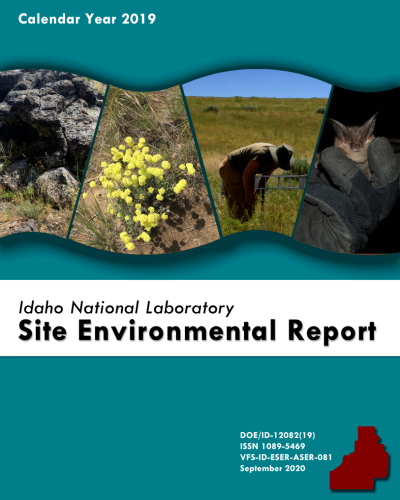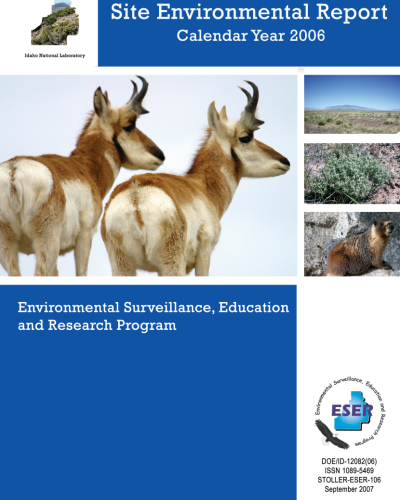Annual Site Environmental Report
Each year, Idaho National Laboratory (INL) prepares an Annual Site Environmental Report (ASER) in compliance with DOE Order 231.1B, Environment, Safety, and Health Reporting, as required by the U.S. Department of Energy (DOE). This report is prepared to inform the public, regulators, stakeholders, and other interested parties about INL’s environmental performance. It summarizes environmental data, the performance of the environmental management system, and INL’s compliance with applicable DOE, federal, state, and local regulations.
Environmental monitoring has been conducted at the INL Site since 1951.
The ASER is published by October 1 each year for the preceding calendar year. The latest reports are available in PDF format. Please note that these files are large and may take some time to download.
INL Environmental Performance



Helpful Resources
Helpful Information
Glossary
2024 Figure/Table Links
Agricultural Products Monitoring
- Locations of agricultural samples collected by the INL contractor (INL contractor)
- Agricultural products, wildlife, soil, direct radiation monitoring by INL Site contractors (INL and Idaho Cleanup Project Contractor)
- Portable lettuce sampler planter photo (INL contractor)
Air Monitoring/NESHAPS
- Air filter heads (left photo). Charcoal cartridge (right photo).
- Atmospheric moisture and precipitation (2024) (INL contractor)
- Atmospheric moisture collection columns
- INL REC source and receptor locations
- INL Site contractors and their regional ambient air surveillance monitoring activities in 2024
- INL Site contractors’ environmental surveillance air sampling locations (INL and Idaho Cleanup Project contractors)
- INL Site conceptual model showing potential routes of exposure/pathways for potential releases
- INL Site major facility airborne source locations
- Location of INL contractor high-volume air samplers at NOAA weather stations (INL contractor)
- Locations of ICP contractor low-volume air samplers at waste management areas sites. (Idaho Cleanup Project contractor)
- Hydrofluorocarbons Phasedown Schedule (OE-3 2021-06)
- Region within 80 km of the INL Site facilities
Effluent Groundwater Monitoring
- INTEC wastewater monitoring for reuse permit (Idaho Cleanup Project contractor)
- Permit monitoring locations for ATR Complex Cold Waste Pond (INL contractor)
- Reuse permit groundwater monitoring locations for INTEC Percolation Ponds (Idaho Cleanup Project contractor)
- Surface water monitoring location at the RWMC SDA (Idaho Cleanup Project contractor)
- Wastewater and groundwater monitoring locations at MFC (INL contractor)
Environmental Direct Radiation Monitoring
Groundwater Monitoring
- EPA final PFAS MCLGs and MCLS
- ICP drinking water sampling summary (2024) (Idaho Cleanup contractor)
- INL drinking water and surface water sampling summary (INL contractor)
- Map of the INL Site showing locations of facilities and corresponding Waste Area Groups
- Groundwater monitoring locations for RHLLW Facility (INL contractor)
- USGS groundwater monitoring locations on and off the INL Site (U.S. Geological Survey)
- USGS monitoring program summary (2024) (US Geological Survey)
- Locations of WAG 2 monitoring wells (Idaho Cleanup Project contractor)
- Locations of WAG 3 monitoring wells (Idaho Cleanup Project contractor)
- Locations of WAG 4/CFA monitoring wells (Idaho Cleanup Project contractor)
- Well locations sampled for Operable Unit 10-08 (Idaho Cleanup Project contractor)
INL Overview
- Big Lost River. Dry riverbed in 2016 (upper). Flowing river in May 2023 (lower)
- Location of the INL Site
- Location of the INL Site, showing key facilities
- INL Site relation to the eastern Snake River Plain Aquifer
- INL Timeline
Quality Assurance
- Flow of environmental surveillance monitoring quality assurance elements
- Laboratory measurement elements
- Quality control program sampling elements
Waste Types
2024 Idaho National Laboratory Annual Site Environmental Report
The 2024 Idaho National Laboratory Annual Site Environmental Report is an overview of environmental management activities conducted on and in the vicinity of the INL Site from Jan. 1 through Dec. 31, 2024.
This report includes:
- Effluent monitoring and environmental surveillance of air, water, vegetation, biota and agricultural products for radioactivity. The results are compared with historical data, background measurements and/or applicable standards and requirements in order to verify that the INL Site does not adversely impact the environment or the health of humans or biota.
- A summary of environmental management systems in place to protect air, water, land and other natural and cultural resources impacted by INL Site operations.
- Ecological and other scientific research conducted on the INL Site which may be of interest to the reader.
2023 Idaho National Laboratory Annual Site Environmental Report
The 2023 Idaho National Laboratory Annual Site Environmental Report is an overview of environmental management activities conducted on and in the vicinity of the INL Site from Jan. 1 through Dec. 31, 2023.
This report includes:
- Effluent monitoring and environmental surveillance of air, water, vegetation, biota and agricultural products for radioactivity. The results are compared with historical data, background measurements and/or applicable standards and requirements in order to verify that the INL Site does not adversely impact the environment or the health of humans or biota.
- A summary of environmental management systems in place to protect air, water, land and other natural and cultural resources impacted by INL Site operations.
- Ecological and other scientific research conducted on the INL Site which may be of interest to the reader.
2024 Annual Site Environmental Report Chapters and Supplemental Reports
2024 Supplemental Reports:
Statistical Methods Used in the Idaho National Laboratory Annual Site Environmental Report
2024 Technical Reports:
Appendix B: Verification Benchmark Problem
2024 Quarterly Environmental Reports:
2023 Annual Site Environmental Report Chapters and Supplemental Reports
DOE/ID-12082 (23), ISSN 1089-5469, INL/RPT-24-76251, September 2024
2023 Report Chapters:
Executive Summary and Helpful Information
Chapter 2 – Environmental Compliance Summary
Chapter 3 – Environmental Management System
Chapter 4 – Environmental Monitoring Programs: Air
Chapter 5 – Environmental Monitoring Programs: Liquid Effluents
Chapter 6 – Environmental Monitoring Programs: Eastern Snake River Plain Aquifer
Chapter 8 – Dose to the Public and Biota
Chapter 9 – Natural and Cultural Resources Conservation and Monitoring
Chapter 10 – Quality Assurance of Environmental Surveillance Programs
Appendix A – Chapter 5 Addendum
Appendix B – Dosimeter Measurements and Locations
2023 Supplemental Reports:
2023 Technical Reports:
Appendix B: Verification Benchmark Problem
Total Effective Dose from INL Airborne Releases for the 2023 ASER Report
2023 Quarterly Environmental Reports:
2022 Annual Site Environmental Report Chapters and Supplemental Reports
DOE/ID-12082 (22), ISSN 1089-5469, INL/RPT-23-74740, October 2023
2022 Report Chapters:
Executive Summary and Helpful Information
Chapter 2 – Environmental Compliance Summary
Chapter 3 – Environmental Management System
Chapter 4 – Environmental Monitoring Programs: Air
Chapter 5 – Environmental Monitoring Programs: Liquid Effluents
Chapter 6 – Environmental Monitoring Programs: Eastern Snake River Plain Aquifer
Chapter 8 – Dose to the Public and Biota
Chapter 9 – Natural and Cultural Resources Conservation and Monitoring
Chapter 10 – Quality Assurance of Environmental Surveillance Programs
Appendix A – Chapter 5 Addendum
Appendix B – Dosimeter Measurements and Locations
2022 Supplemental Reports:
2022 Technical Reports:
Attachment to Appendix B: Verification Benchmark Problem
Total Effective Dose from INL Airborne Releases for the 2022 ASER Report
2022 Quarterly Environmental Reports:
2021 Annual Site Environmental Report Chapters and Supplemental Reports
DOE/ID-12082(21), ISSN 1089-5469, INL/RPT-22-68974, September 2022
2021 Report Chapters:
Executive Summary and Helpful Information
Chapter 2 – Environmental Compliance Summary
Chapter 3 – Environmental Management System
Chapter 4 – Environmental Monitoring Programs: Air
Chapter 5 – Environmental Monitoring Programs: Liquid Effluents
Chapter 6 – Environmental Monitoring Programs: Eastern Snake River Plain Aquifer
Chapter 8 – Dose to the Public and Biota
Chapter 9 – Natural and Cultural Resources Conservation and Planning
Chapter 10 – Quality Assurance of Environmental Surveillance Programs
Appendix A – Environmental Statutes and Regulations
Appendix B – Chapter 5 Addendum
Appendix C – Onsite Dosimeter Measurements and Locations
2021 Supplemental Reports:
Statistical Methods Used in the Idaho National Laboratory Annual Site Environmental Report
Summary of Historical Environmental Monitoring
2021 Technical Reports:
Attachment to Appendix B: Verification Benchmark Problem
Total Effective Dose from INL Airborne Releases for the 2021 ASER Report
2021 Quarterly Environmental Reports:
ASER (1999-2020)

2020 ASER

2019 ASER

2018 ASER

2017 ASER

2016 ASER

2015 ASER

2014 ASER

2013 ASER

2012 ASER

2011 ASER

2010 ASER

2009 ASER

2008 ASER

2007 ASER

2006 ASER

2005 ASER

2004 ASER

2003 ASER

2002 ASER

2001 ASER

2000 ASER

1999 ASER
Program Areas
Environmental Monitoring
The lab’s Environmental Monitoring program performs constant monitoring to check for these contaminants and ensure that the environment is safe for people, wildlife and vegetation. The team collects environmental samples at the desert Site and surrounding areas.
Natural Resources
The INL desert Site consists of 890-square miles of land and is a critical component to the Department of Energy-Idaho’s understanding of environmental resources in southeast Idaho. INL has a natural resources team that provides ecological support for vegetation and wildlife at INL.
Environmental Publications
INL publishes a variety of reports as part of its commitment to environmental stewardship and full compliance with environmental protection laws and regulations. These reports ensure that the lab’s mission can be achieved with little to no impact on the environment, wildlife and vegetation.





